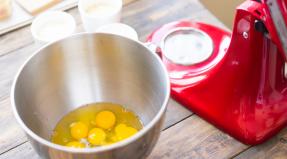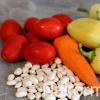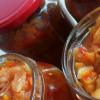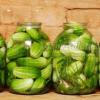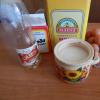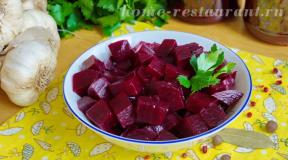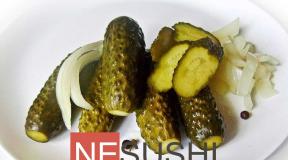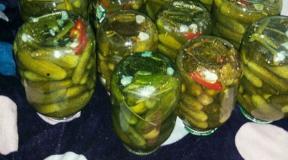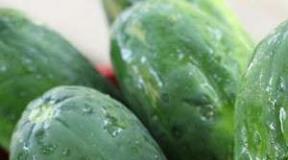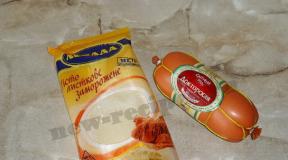How to store fruit in the refrigerator. Optimum conditions and storage temperature of vegetables and fruits
Storage of fruits and vegetables
Fruits and vegetables are essential for a balanced and healthy diet. as well as cereals, meat and dairy products. They provide us with important nutrients: vitamins, minerals and fiber. Due to improper storage, fruits and vegetables deteriorate rapidly. In addition, vitamins are especially sensitive to temperature and light. So, proper storage of fruits and vegetables allows you to save vitamins for a long time. In this article you will discover how to store vegetables and fruits, keeping them for a long time fresh and full of healthy ingredients.
Proper storage of fruits and vegetables
Different fruits and vegetables require different storage conditions. Especially important role played in the proper storage of vegetables and fruits, depending on their origin, is played by temperature and humidity.
Most of the population keeps fruits and vegetables in the refrigerator without hesitation. On the other hand, for tropical fruits such as bananas or melons, this is not at all the right place. Due to the low temperature, the cells of the fetal tissue are damaged, and bananas are covered with brown spots. To store vegetables and fruits grown in the southern climate, it is best at a temperature of 8 to 13 degrees.
If the storage of vegetables and fruits occurs in a cooler place, they lose up to 70 percent of their vitamins within two days. In addition to heat, vitamins are very sensitive to light. Therefore, fruits and vegetables that you do not have in the refrigerator, it is best to store in a dark place.
Temperature is crucial
The following fruits and vegetables can be safely stored in the refrigerator:
Fruits: apricots, pears, peaches, nectarines, cherries, strawberries, blueberries, raspberries, gooseberries, currants, grapes, kiwi and plums
Vegetables: broccoli, cauliflower, carrots, kohlrabi, mushrooms, corn, leeks, lettuce, spinach, radishes, Brussels sprouts, asparagus, Chinese cabbage and green peas.
Fruits that are stored in the refrigerator should be placed in open plastic bags to protect the fruits from drying out.
A little warmer - the ideal temperature for storing vegetables and fruits from warm countries is 8-13 degrees.
Fruits: melon, mango, lemon, papaya, pineapple and grapefruit
Vegetables: tomatoes, sweet peppers, zucchini, cucumbers, onions, potatoes, garlic and eggplants
To ensure their storage is easiest in the basement or storage room. This is much better because it is too warm at room temperature and too cold in the refrigerator for long-term storage. And bananas are best stored at a temperature of 12 to 15 degrees.
How to store fruit
How to store vegetables and fruits
- Apples: Apples become wrinkled over time because they lose water. Therefore, it is better to store apples in a room with high humidity, for example in the basement. Apples should never be stored with other fruits, because they produce large amounts of ethylene.
- Bananas: Bananas are not stored in the refrigerator, because there they quickly become covered with brown spots. In a dry cool place, bananas can be stored for up to 3-4 days.
- Strawberries: Strawberries should be stored only in the refrigerator. These berries are very delicate and deteriorate quickly, so they are stored for no more than two days. Strawberries should also be stored so that the berries are not subjected to any pressure, otherwise you will get a sweet bruised fruit.
- Melon: Melons are best kept in the basement or in a cool closet. If the melon is already cut, it is better to keep it wrapped in plastic wrap.
- Plums: Plums should be kept unwashed in the refrigerator. Thanks to the white bloom that covers the plums, the fruits are protected from drying out.
- Grapes: Grapes like plums should also be washed just before eating. Otherwise the grapes dry out faster.
- Cucumbers: cucumbers should not be stored in the refrigerator. They stay fresh for a long time at about 15 degrees. Therefore, cucumbers are best kept in the basement or in the pantry.
- Carrots: Carrots can be stored in the refrigerator - preferably in a plastic bag with holes. The tops should be cut off. As it continues to grow, it consumes water, and carrots can be wrinkled.
- Asparagus: Asparagus is best eaten as fresh as possible. In the refrigerator, keep no more than a day wrapped in a towel.
- Tomatoes: Tomatoes in the fridge where they quickly rot. They should be stored in a dry, cool place. Tomatoes should never be stored with other vegetables, as they produce large amounts of ethylene.
- Zucchini: Squashes, like cucumbers, are very sensitive to cold. It is best to keep them in a cool dark place.
For proper storage of vegetables and fruits, you should know that tomatoes and apples should not be stored with other fruits and vegetables. It is established that they emit ethylene in large quantities. This gas drives ripening processes and thus ensures that fruits and vegetables ripen and deteriorate faster. Other fruits, such as bananas or apricots, also produce ethylene, although in smaller quantities than apples and tomatoes.
If you bought an immature fruit, you can take advantage of this effect: put an apple or tomato in the immature fruit, and the ripening process will be accelerated.
Remember that different types of vegetables, such as cucumbers, cauliflower, lettuce and cabbage, are very sensitive to ethylene, you should always keep these fruits and vegetables separately.
Despite all the tips on how to store vegetables and fruits, you should always keep in mind that fruits and vegetables are best tasted fresh. Storing vegetables and fruits should not be too long, because even if vegetables and fruits are stored in optimal conditions, they lose all the time in valuable nutrients. So buy as many fruits and vegetables as you need for the next two to three days.
Not always those products that we carefully select in the supermarket and on the market live to our table. This may be due not only to our forgetfulness and quality of products, but also their improper storage. In this post we have collected the main principles that will help to preserve a maximum of freshness and benefits of vegetables, fruits, herbs and other products.
· one ·
Properly organize the refrigerator
The space of the refrigerator is not for nothing divided into different sections - each of them has its own temperature regime and different air circulation. Dairy products should be stored on the top shelf, on the middle shelves - cooked products, on the bottom - raw meat and fish (which must be kept separate from other products to avoid their infection). Bottom shelves are specifically designed for storing vegetables and fruits, which are also recommended to be stored separately from each other.

・ 2 ・
Keep fruits wisely
Most fruits do not have to be refrigerated - they can be stored at room temperature. The window sill in our kitchen is always decorated with fresh fruit laid out on it. So they are always in our sight and eaten faster than if they were hiding in the refrigerator. If you like to buy fruits for the future, store them in the refrigerator in specially designated sections for fruits and vegetables, where the temperature is usually kept at 8-10 ° C. Try to keep fresh fruits and vegetables in these sections in order not to overfreeze them. Supercooled vegetables and fruits lose their structure and flavor. Also, eating them too cold is not the most pleasant thing. Exceptions include bananas. The frozen bananas added to the smoothies taste like ice cream. The main thing - send the bananas in the freezer, peeling them from the skin.
☆ The berries have a very thin shell, they easily break, secrete juice, and on the second day they can become covered with mold. It is best to arrange the berries in a single layer in cardboard boxes and put them in the fridge.

・ 3 ・
Attention: ethylene!
Many fruits emit a special colorless ethylene gas, which accelerates the ripening of vegetables and fruits. Large amounts of ethylene produce apples, pears, bananas, figs, plums, avocados and tomatoes - they should be stored separately from other vegetables and fruits so that they do not oversleep ahead of time. Or vice versa, if you want some fruit to ripen as soon as possible, put it in a bag with one of the fruits that produce ethylene.
☆ To accelerate the ripening of green tomatoes, ripe red ones are among them. A couple of apples or bananas can be put in one packet with solid avocados or kiwi - they will become softer faster.

· four ·
Her Highness Greens
Parsley, dill, cilantro, basil - all greens with stems should be stored according to the same principle as fresh flowers. Cut greens by 0.5-1 cm and put them in a glass with cold water. So thin leaves will not lose moisture and will not wilt ahead of time. Glass with greens can be removed in the refrigerator.
Spinach, arugula and other leafy greens, which manufacturers like to pack tightly in plastic packaging, quickly deteriorate during such storage. When the leaves are tightly packed in the package, they break, darken and fade quickly. To avoid this, rinse the leaves under cold water and shake off the moisture (a special dryer for greens here helps a lot). Then put the greens in a spacious vacuum container and, tightly closing the lid, put in the refrigerator.
· five ·
Nuts love the cold
Nuts and seeds contain a lot of vegetable fats, which tend to be rancid if stored improperly. Ideal - buy and store nuts in the shell. Then it is enough to pour them into glass, clay or plastic dishes with a tightly closed lid and put in a dark cool place. It is much more convenient to use peeled nuts, but they deteriorate faster, so they should always be kept in the refrigerator.
☆ If you buy peeled nuts and seeds for future use, you can extend their freshness for several months using the freezer. Put the nuts in a hermetically sealed container and thaw exactly the amount you need before eating.

・ 6 ・
Remove tomatoes and onions from the fridge.
Many vegetables are well kept at room temperature. Simply protect them from sunlight and humidity. For example, onions and garlic have a very dense shell and are well stored without cold temperatures. Potatoes, carrots, beets and pumpkins are stored longer than other vegetables due to their dense structure. To store them, you can select a large box in the kitchen or store in thick canvas bags.
☆ In the fridge, you also should not remove tomatoes - from this they acquire a powdery structure and lose their flavor.

・ 7 ・
Clean - the guarantee of health
At least once a month wipe all the shelves of the refrigerator. In fruit boxes it is worth to have a special antibacterial sponge mat so that there is an additional air cushion between the fruit and the refrigerator that protects against mildew. Cooked products and products with a pungent smell try to keep them in tightly closed containers so that their flavor does not soak the entire refrigerator.
☆ Do not forget to monitor the freshness of the products. Do not throw away spoiled food on time - quite dangerous. Mold spores and putrefactive bacteria can spread to other products. Therefore, ruthlessly send spoiled cucumbers and zucchini in a garbage can, and even better, try not to clog the refrigerator with those products that you do not have time to eat.
To begin with a small lesson in chemistry. Ethylene is an odorless and colorless gas that helps some fruits ripen. In some fruits it is a lot of it (for example, apples and pears), and in some - it is negligible.
- apples,
- apricots,
- avocado,
- bananas
- melons
- figs,
- nectarine,
- peaches
- pears
- plums
- tomatoes
They should not be stored with other fruits and vegetables. Unless you want them to be faster.
For example, if you put a banana in a paper bag, it will ripen faster, as ethylene will be in a paper trap. Or you can put an apple or a pear along with a banana.
It is also worth considering the fact that ethylene comes out of a damaged fetus faster. As a result, one cracked apple can make the whole package spoil faster than usual.
What and where to store
After going to the market or to the store you need to put the purchased in the right place. Otherwise, all efforts and money will be wasted.
In the refrigerator are stored:
- Artichokes
- Beet
- Brussels sprouts
- Celery
- Cherry
- Grapes
- Green bean
- Lima beans
- Leafy vegetables
- Leek
- Spinach
- Sprouts
- Zucchini
For storage in the refrigerator, you have three options: store without a bag, in a plastic bag or in a paper bag. A plastic bag holds moisture inside, so it is best not to tighten it tightly or to make several holes.
It is advisable not to wash the vegetables and fruits before sending them to the refrigerator. If you have washed them, dry them well, otherwise mold may appear, which is not very good for other products and your health.
After ripening stored:
- Avocado
- Nectarines
- Peaches
- Pears
- Plums
Store in water:
- asparagus
- greenery
You need to store the same way as if you were storing flowers: cut off the tips and put in a glass with a little water.
Store in paper bag:
- mushrooms
Do not wash and store in a plastic bag:
- Broccoli
- Carrot
- Cauliflower
- Corn
- Cranberry
- Green onions
- Lettuce
- Peas
- Radish
Do not wash and store, laying out in one layer:
- Blackberry
- Blueberries
- Strawberry
- Raspberries
These berries can not be washed and put a large number in one tray. The berries are very tender, and their skin is also soft. When washing you damage them, the juice flows out and they just sour. If you store them in small trays in a single layer, they will hold much longer.
Stored on the kitchen table:
- Apples
- Bananas
- Tomatoes
- Basil
- Cucumbers
- Eggplant
- Ginger
- Grapefruit
- Lemon
- Oranges
- Mango
- Papaya
- Pepper
- Persimmon
- A pineapple
- Bananas
- Watermelon
- Garnet
Listed vegetables and fruits are not advisable to put in direct sunlight or near a stove. From time to time you need to shift them from place to place, so that the fruit is not lying on the same side for a long time. This is especially true of tomatoes.
Store in a cool dark place:
- Garlic
- Potatoes
- Pumpkin
- Leek
Not in vain in the villages are so popular cellars. After all, not only pickles and preserves are stored in them all winter, but also potatoes, onions, pumpkins and garlic.
Storage conditions for fresh vegetables, fruits and berries
It is not enough to grow and harvest a good crop or buy high-quality, inexpensive vegetables on the market. It is very important to preserve or process them correctly, that is, so that they do not lose most of the vitamins and nutrients. The fact is that even after harvesting vegetables and fruits continue to live, breathe, spend nutrients; and the quality and safety of products depend on how intensively these processes take place.
The main disadvantage in the storage of vegetables and fruits is associated with the loss of moisture, vitamins, organic acids and carbohydrates. Therefore, it is necessary to create conditions under which these losses will be minimal. However, not all vegetables, berries or fruits, even when properly stored, remain fresh until the new harvest. As a rule, the more delicate products (raspberry, peach), the less shelf life. So, for example, during storage of garden strawberries at a temperature of +1 ° C for 2 weeks, not only does the appearance of the berries deteriorate, but the content of vitamins also decreases. At the same time, onions in suitable conditions can be stored without special losses for 6-7 months.
All types of berries, vegetables and fruits in terms of storage can be divided into 3 groups.
So, among the vegetables emit:
- Vegetables with a long shelf life are represented by 2-year-olds, i.e. plants that give seeds for the 2nd year of life. These are, for example, such root vegetables as carrots, beets, radishes, turnips, and others; these also include all your favorite potatoes, cabbage, garlic,. Being at rest during winter storage, these vegetables continue biological processes aimed at planting buds that will grow in spring, therefore, the main task of any housewife is to prevent, first, germination and, second, the development of diseases. Under optimal storage conditions, such vegetables are able to reach the new crop with minimal losses;
- Vegetables with an average shelf life include fruit vegetables (, cucumbers,) and melons (,). In vegetables of this group, the keeping quality depends on the degree of ripeness at the time of removal and on the storage mode. Moreover, for various types of vegetables in this group, the shelf life is in a fairly large range - from a few weeks in pumpkin and zucchini and up to several months in cucumbers. Therefore, it is wiser to process most of these vegetables into canned vegetables;
- Vegetables with a short shelf life are mostly green crops: lettuce, green onions, spinach, sorrel, dill, etc. Their shelf life is no more than a week, and then only if they are properly stored.
The same gradation of shelf life exists in fruits and berries:
- Fruits with a long shelf life are apples and pears of winter varieties, as well as late-ripening grapes. In good storage, they can lie without loss of consumer qualities from 3 to 6 months. Cranberries, citrus fruits, pomegranates and nuts are well kept;
- Fruits with an average shelf life are the same apples, pears and grapes, only average ripening periods or, as they are also called, autumn varieties. They are able to be stored for about 1 to 3 months, so you should not store them in large quantities, or to let a part of it for processing by preparing juices or compotes. Quince, mountain ash, lingonberry, etc .;
- Fruits with a short shelf life are represented by stone fruits (cherry, plum, cherry, apricot, etc.), summer apples, pears and grapes, as well as almost all types of berries (raspberries, blackberries, currants, gooseberries, etc.). The shelf life of these fresh fruits and berries is a maximum of 1-1.5 weeks, so it’s better to process them in the first days after harvest.
The shelf life of berries, vegetables and fruits during storage depends on several factors.
Consider the most important of them.
Observing the conditions and terms of storage of fruits and vegetables, you can have fresh stocks all winter.

Potato storage
Firstly, in order to store fruits and vegetables for storage in storage, it is necessary to optimally select varieties. Late varieties have the best keeping quality, therefore, the preparation for storage of the products grown by you begins long before the fruits ripen.
First, carefully select varieties both in terms of ripening and on the growing conditions to which your land plot corresponds. When buying vegetables on the market, do not rush, buy at the time when the mass harvest of late vegetables begins; By the way, at this time and the price for them is much reduced.

Beet storage
Secondly, observe the right growing conditions. Cultivating vegetables, do not strive to make large doses of fertilizer. After all, not only the lack of nutrients in the soil, but also their excess has a negative impact on the safety of plant products. So, with an excess of nitrogen fertilizers, vegetables become watery and quickly rot. The main task of any summer resident is to grow healthy vegetables that will feed you all winter.

Third, in order to keep vegetables and fruits as fresh as possible, follow the correct texture of the soil. The best vegetables are known to be grown on light structural soils containing a large percentage of oxygen. This is especially true of such root vegetables as potatoes, carrots and beets. It is easier for vegetables to grow in such soil and accumulate nutrients.
Such a factor as weather conditions, unfortunately, depends little on a person, but it must be taken into account when making supplies for the winter. Negatively on the state of vegetables and fruits affects both raw cold and too hot dry summer. In the first case, the grown products are subject to various diseases, in the 2nd vegetables and fruits contain a low percentage of nutrients. Therefore, in the autumn, think: maybe it is better to recycle most of the products (dry, ferment, salt or freeze) than throw it away in winter or early spring.
For the storage of fruits, vegetables and berries in the winter, it is necessary to create optimal conditions for them, i.e., to have a storage in which you can maintain an optimal regime. There are a large number of different designs of vegetable stores.

Before storing fruits and vegetables, first of all, the storage needs to be aired. Do not do this in the summer in hot weather, as a strong stream of warm air will cause large amounts of condensation on the ceiling and walls. This work should be carried out in the autumn at lower temperatures, when it does not lead to the formation of excessive moisture.
Another important item on how to properly store vegetables and fruits is obligatory disinfection of the vegetable store. For what you can burn a few sulfur bombs (1 piece per 10 m3). Working with them is required very carefully, adhering to all precautions. The fireball is set on fire in a storage facility, setting it on a metal stand away (no closer than 0.5 m) from flammable objects. Before ignition, vents, slots, etc. are tightly closed, and after ignition, the entrance is tight. After 2-3 days of treatment the room is thoroughly aired. The sulfur checker will help get rid of not only various microorganisms, but also kill insects and rodents.
Also, the storage technology of vegetables, fruits and berries provides for whitewashing the ceiling and walls of the store with lime mortar with the addition of a small amount of copper sulfate. It is better to remove and dry the wooden shelves and drawers in the sun, and then spray it with a 5% solution of copper sulphate. If in the past winters storage froze through, warm it with sheets of expanded polystyrene. This simple and inexpensive operation will have a positive effect on the keeping quality of the stored products, especially potatoes, which, as is well known, have an unpleasant taste and texture in a frost-bitten condition.
Temperature regime for proper storage of vegetables and fruits
Different types of vegetables and fruits require storage modes that are individually selected, that is, create conditions under which biochemical processes are slowed down, the activity of harmful microorganisms and bacteria is reduced, which ultimately has a beneficial effect on the safety of products.
What does the storage mode include? These factors include indoor temperature, air humidity, air exchange, air composition, light and product placement.
Subject to the conditions and terms of storage of most fruits and vegetables produced at low temperatures. This temperature mode provides slower respiratory energy and as a result of this - lower consumption of nutrients and reduction of moisture loss. However, in practice this means constant temperature control, because lowering it even by a few degrees can lead to spoilage of vegetables and fruits. The best storage conditions are provided only with constant temperature. Its sharp drops increase the intensity of respiration of plant products and cause various diseases.
In general, according to the temperature regime of storage, all vegetables and fruits can be divided into 3 groups:
- well preserved at a temperature of 0 ° C and slightly lower: onion, garlic, white cabbage;
- well preserved at a temperature close to 0 ° C or slightly higher. This is the largest group of vegetables and fruits, which includes roots, melons and gourds, apples, pears, etc .;
- well preserved at a temperature of +2 to +10 ° C: potatoes, citrus fruits, tomatoes, etc.
Since the temperature storage of fruits and vegetables is one of the most important factors for the safety of plant products, it is very important to choose the right temperature for each crop.
Not less than temperature, humidity of storage of vegetables and fruits is also important. This factor significantly affects the safety of plant products. On the one hand, to prevent the evaporation of moisture from vegetables and fruits, it would be good to keep them at 100% humidity, and on the other hand, this humidity is a favorable environment for the development of various microorganisms, including mold.
Thus, air humidity in the range of 70 to 95% is considered optimal for storing fruits and vegetables. Such a wide range of humidity levels is caused by the fact that higher humidity (90–95%) is required for storing root crops and potatoes, while onions and garlic are much lower (75–77%).
The sources of moisture in the room are both the vegetables and fruits themselves, and artificial sources that you can use, for example, a bucket of water if necessary. On the other hand, at very high humidity in the storage, it is easy to reduce it using ordinary table salt, which is an excellent desiccant. You can pour about 10-15 kg of salt in any wide container or bring a few red bricks, which also absorb excessive moisture.
It must also be remembered that when the temperature of the air is low and the humidity is high, the persistence of the stored products can sweat, which will inevitably lead to germination of the spores of microorganisms and food spoilage. You can only fight this nuisance in one way - the temperature and humidity in the storage must be stable.
For proper storage of fruits and vegetables, proper air exchange is important. Airing storage is necessary to remove excess heat and moisture, which inevitably accumulate during storage of large quantities of plant products. Air exchange contributes to maintaining the stability of the temperature and humidity conditions and maintains an optimal composition of the air environment.

Ventilation room for vegetable storage
Ventilation used in vegetable stores can be both natural and forced - it all depends on your choice and conditions.
Storage of vegetables and fruits in normal conditions occurs at normal oxygen content in the atmosphere (21%), as well as carbon dioxide and other gases. However, it must be remembered that vegetables and fruits, when breathing, like all living organisms, absorb oxygen and release carbon dioxide.
When a large amount of CO2 is accumulated in the storage (more than 10%), the quality of the stored products deteriorates, therefore, fresh air or regular ventilation is necessary.
There are several ways to store fruits in a controlled gaseous environment, and one of the simplest is the use of synthetic polymer films (polyethylene, etc.). In packages of similar materials into which the fruits are placed, a certain gaseous environment is naturally created, the concentration of CO2 increases and the oxygen content decreases due to the breathing of the fruits themselves.
To preserve vegetables and fruits as long as possible, it is important to provide the right lighting. Fruits, berries and vegetables should be stored in a dark room, since biologically active substances, such as vitamins, are destroyed in the light. In addition, in the light of vegetables such as potatoes or carrots, during greening, there is an accumulation of a toxic substance - solanine.
How to store vegetables and fruits: storage preparation
In the process of how to store vegetables and fruits, it is necessary to protect them from infection. Since during storage of the fruits they may have various diseases, some preventive measures should be taken before laying them for the winter. First of all, the harvest should be taken in dry weather, after which the harvested products should be dried in the sun and bruised carefully, setting aside damaged specimens, which should be consumed in the near future.
 Storage preparation
Storage preparation  Vegetable storage
Vegetable storage
It is impossible to lay products into cold storage immediately after these procedures. For proper storage of fruits and vegetables, the temperature should be reduced gradually to avoid temperature shock. Only around mid-October, the code will reveal the hidden diseases of the products, and its temperature will be approximately equal to 8-9 ° C, it must again be sorted and removed in the storage. Of course, these are medium terms, which depend on the weather and on the climate in your region, but in about 1-2 months the vegetables and fruits should be cooled.
When preparing fruits and vegetables for storage, the harvest should be properly dried and treated with protective fungicides to prevent fungal diseases. You can do this and infusion of common nettle. For what her stalks pour cold water and insist day.
Carrots are a rare exception among vegetables because they contain more nutrients when cooked than in cheese. According to Western experts, immediately after cooking, the level of antioxidants in root vegetables increases by 34%.
For high preservation of vegetables, it is also necessary to remove them in time, that is, firstly, to allow them to fully ripen, and secondly, to prevent damage by frosts. In unripe vegetables have not yet had time to form a sufficiently strong shell, which is easily damaged during harvesting and transportation. As a result, they are poorly stored. Overpowered products lose a lot of nutrients, often cracking, especially white cabbage, which also adversely affects the shelf life. When harvesting, try as carefully as possible to deal with vegetables and fruits, which will lay on long-term storage. Be sure to sort them, selecting the broken, cut, sick, non-standard, etc. for processing or eating in the first place. If all storage conditions are observed, good results can be obtained, at which the safety of basic vegetables (potatoes, cabbage, carrots and beets) will be approximately 90-95%.
According to the rules of storage of fruits and vegetables, placement of plant products in the storage should be made taking into account the specific storage of each species.
In addition, many types of products affect each other, which sometimes leads to a deterioration in their consumer properties. So, it is well known that storing a number of apples and potatoes leads to the fact that the taste and aroma of apples become earthy, and therefore eating them is unpleasant.
Also, onions and carrots should not be stored side by side because they have different requirements for air humidity. "Not get along" next to potatoes and cabbage, as they need different temperature conditions.
How to store fresh fruits and berries
Mostly, only winter varieties of apples and pears are deposited. The fruits must be ripe, and it can be determined by the following features:
- fruits have a characteristic color for the variety;
- fruits get flavor;
- the bones in the fruit are brown in color;
- the fruits on the tree are not firmly held.
How to keep fruits and berries fresh as long as possible? Remove the fruit from the tree or bush in dry weather. Do this very carefully, removing the fruit along with the stalks and injuring them as little as possible. Usually in winter varieties there is a wax coating, which is a natural protection against moisture and pest microorganisms, therefore, in order not to disturb it, it is best to collect fruits with gloves.
There is an opinion, however, not confirmed by any research that the apple eaten in the morning helps to wake up. Maybe this is not so, but the benefits of an apple for the body will be undeniable.
During the winter storage of apples and pears, the transformation of pectin, the sticking agent contained in these fruits, is of great importance. For our body, it is an orderly because it has the ability to bind and remove various harmful and toxic substances, such as pesticides or radioactive elements. So, during storage of fruit, the secondary structure of pectin is destroyed, the fruits become softer and tastier. Unfortunately, in the process of laying, vitamins start to break down; Vitamin C is the least resistant of them, so by the beginning of summer 100 g of the product contains less than 1 mg% of apples and pears, while right after harvest it reaches (depending on the variety) up to 16 mg%.
What else you need to be sure to remember is that it is strictly forbidden to store apples and pears in one room with garlic, onions and potatoes. The specific smell spread by these plant products is very easily absorbed, which means that the taste of the fruit will be hopelessly spoiled.

Apple storage
Apples. Before storing the apples, it is necessary to sort them by size and select those damaged by diseases and pests, as well as those that are mechanically damaged. Fruits of medium size are stored longer, small ones are preferable to be processed, as they fade quickly enough; but large apples, since they are more often affected by diseases, it is advisable to eat first.
Selected fruits should be stored in wooden or cardboard boxes. This will not only protect them from mechanical damage, but also create the most stable temperature conditions. It is advisable to isolate the apples from each other by wrapping them in paper or pouring them with any suitable material, such as husks, buckwheat husks, moss, washed and thoroughly dried sand, soft hardwood shavings, etc.
Sometimes apples are stored in the straw, but this is somewhat worse, since with condensation of moisture, it can start to rot, which inevitably leads to damage to the fruit. Small amounts of fruit can be stored in plastic bags, which are tied with string and hung from the ceiling.
Before storage, each fruit can be pretreated with a 2% solution of calcium chloride or an alcohol solution of propolis.
Packed boxes of fruit are transferred to a cool place for the night, so that the fruit is pre-cooled, and then placed in a permanent place in the store. The optimum temperature for storing apples is 0– +1 ° C, and the air humidity should be 85–95%. From time to time the stored products must be inspected.

Pear storage
Pears Pears are stored in almost the same way as apples, considering only the fact that they are more delicate fruits and should be injured as little as possible. Therefore, pears are harvested only in gloves, immediately sorting them, wrapping them in thin soft paper and putting them in boxes. The layout is carried out diagonally, placing the fruit in such a way that the stem is between the fruits of the next row.
Pears are stored at a temperature of -1-0 ° С and relative air humidity in the storage facility of 85-90% with good ventilation.
You can store pears in sealed plastic bags with dimensions of 65x 18 cm, just pay attention that you can fill them with fruit only after they have cooled to the storage temperature. Otherwise, condensation will appear in the bags and the pears will simply rot.

Grape storage
Grapes. Under all conditions, it is possible to preserve fresh such delicate crops as grapes. Especially great damage caused by the storage of products causes mold, which affects both berries and comb.
How to store fresh berries, what to do to solve this problem? We describe from the beginning. First of all, the grapes must ripen. Clean it in dry sunny weather, cutting off the brush with a piece of vine.
When laying the crop for storage carefully inspect each brush, remove the damaged berries. On the remaining berries, try to maintain a wax coating, as it performs a protective function. The grapes should be completely dry, so if necessary, gently blot it with a soft cloth.
Before fresh berries, provide a temperature of 0– + 2 ° С with a humidity of 90–95%. At the same time storage should be well ventilated.
You can store grapes in several ways:
- The brushes are folded into clean (you need to fumigate them with gray) yashiki or kegs, pour in wood (preferably lime or poplar) sawdust and cover with lids. Sawdust must also be clean. It is advisable not to store in 1 container more than 8-12 kg of grapes. Instead of sawdust, it is permissible to take straw ashes, just make sure that there is no impurity of earth or peat in it;
- Brushes are tied up in pairs by the legs and hung on poles so that they do not touch each other;
- The brushes are laid out on the shelves, laying a 2-3-centimeter layer of straw under them. The clusters are laid out in rows one by one;
- If you want to save small amounts of products, the grapes are stored in jars of water, lowering the brush legs with legs down like bouquets. A pinch of salt is added to the water or pieces of charcoal are put.

Watermelon storage
Melons and watermelons. This problem is relevant in the southern regions, where large harvests of melons and gourds are harvested. Ripe watermelons that have just been picked are picked for storage and coated with a clay mash with the addition of finely chopped hay. Then the fruit is dried in the sun and inspected. In the presence of cracks, the plastering is repeated until the crust becomes solid.
Watermelons thus treated are stored in a cool dry place, shifting them with hay. Experiments have shown that in this case the fruits are well preserved until March. Watermelons can also be treated with paraffin or alabaster and then suspended in nets to the ceiling.
Watermelons, which are spread out on the shelves with tails up, are well stored, it is only necessary to leave a distance between them so that they do not in any way touch the sides. The storage time in this case will be about 2-3 months at a temperature of + 3-4 ° С and 80% humidity.
Note: Watermelons do not ripen during maturation, therefore, only ripe fruits should be stored. Melons are just the opposite: cleaned in a state of milky-wax maturity, put in barrels and poured with dry wood ash. The main condition - they should not touch each other and the walls of the barrel. Top poured a thick layer of ash and hermetically sealed. The barrel is left in a cool dry place. Thus, melons remain fresh for 3-4 months.

Winter varieties of melons are well stored in netssuspended from the ceiling, at a room temperature of + 2-4 ° С and air humidity of 70-80%. However, you will need to constantly inspect the fruit, because even the smallest speck that appears on the peel can rot the whole melon or make it taste unbearably bitter. The main condition: putting the melons in storage, make sure that they do not have even minimal mechanical damage.
Vegetables and fruits, of course, it is better not to keep at all, but always to buy fresh, but ... if stored, then correctly, without loss (taste and appearance).
The following are the ideal methods (ideal, according to this textbook), the temperature of storage of vegetables and fruits. How to achieve them at home, I can not imagine, but it is still important to know at least what kind of vegetables and fruits can be stored in the refrigerator and on what shelves.
I even specifically conducted a study that measured the temperature on the upper and lower shelves of my fridge (top freezer): on the top shelf - +6, but if you turn on the freezer stronger, it turns out to be colder, on the lower shelf - +9.
If you keep garlic and oranges in the fridge, then we go to you this post for you!
Artichokes
They can be stored in a cool (+10 - +12) place for several days. Artichokes are "afraid" of light and low temperatures.
Eggplant.
You can store them only a few days at +10 - +12, without subjecting them to thermal shock.
Grapes
Store at +8 - +12 and pull out an hour before eating.
Green peas (fresh).
Keep a maximum of 48 hours at a temperature of +6 - +8.
Pear.
Store ripe fruit at +6 - +8.
Squashes.
Can be stored at +8 - +12 maximum.
Cabbage.
It can be stored for a maximum of 4-5 days at a temperature of +8 - +10.
Potatoes.
Store at +10 - +12. Temperatures above +15 and an abundance of light accelerates the ripening process.
Bow.
It is better to store onions “in one layer” in a place inaccessible to light and moisture.
Leek.
Stored at +6 - +8.
Carrot.
At temperatures below +6, it quickly begins to deteriorate. It is better to store it at a temperature of +10 - +12.
Cucumbers.
Store at +6 - +8. They are afraid of temperatures below +6 and brutal shock (they should be treated gently :)).
Sweet pepper.
Store at +10 - +12, avoiding thermal shock.
Radish.
It is better not to store it, and if stored, then at a temperature of +6 - +8.
Turnip.
Store at +10 - +12. When stored for a long time, turnip dries and gets too strong taste.
Salad.
Keep 48 hours maximum at +6 - +8.
Beet.
Boiled beets should be stored in the refrigerator at a maximum of +3. Ordinary beets can be stored at +8 - +10 in a place inaccessible to light.
Celery.
Green branches and stems should be stored at +6 - +8 in a place inaccessible to light and humidity (at high humidity, the stems begin to "rust", ie, turn brown).
Celery root is stored at +8 - +10.
Asparagus.
Store at +6 - +8, covered with plastic food film or a wet towel.
Aromatic herbs (dill, parsley, basil, tarragon, etc.)
Store them in the refrigerator, covered with a wet towel or plastic. Roots better immersed in water.
Green beans.
It is better to store them no more than 48 hours at a temperature of + 6 - +8.
Fennel.
Store at +6 - +8, covered with a wet towel and separate from other products, as its smell is quickly transmitted to "neighbors".
Citrus.
It is better not to store them in a cold place and close to other products (citrus has a strong aroma). Avoid thermal shock.
Garlic.
It is best kept in plastic or metal containers at a temperature of +15 - +18. Air should flow easily into the storage area, but not light, humidity and dust.
Champignon.
It is better not to keep them, but to buy fresh. But they are stored at a temperature of +8 - +10 in a place inaccessible to light.
Spinach is fresh.
It is stored at a temperature of +6 - +8 for 24 hours, then nitrites, harmful to our health, begin to form in it.
Apples.
Store ripe apples at +6 - +8 for a maximum of 1 week. Higher temperatures accelerate the ripening process.
By the way, if you put any vegetable or fruit next to an apple (at room temperature), it will ripen faster.
*** Apples produce ethylene gas during storage, which accelerates the ripening of many fruits. Read more

